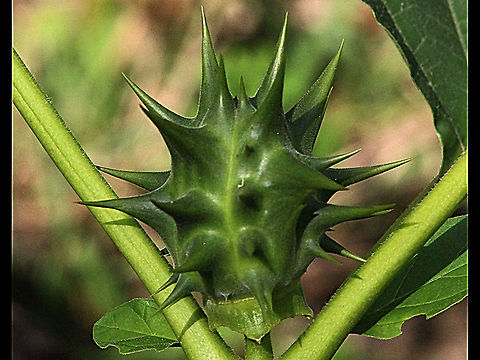
Appearance
"D. stramonium" is a foul-smelling, erect, annual, freely branching herb that forms a bush up to 60 to 150 cm tall.The root is long, thick, fibrous, and white. The stem is stout, erect, leafy, smooth, and pale yellow-green to reddish purple in color. The stem forks off repeatedly into branches and each fork forms a leaf and a single, erect flower.
The leaves are about 8 to 20 cm long, smooth, toothed, soft, and irregularly undulated. The upper surface of the leaves is a darker green, and the bottom is a light green. The leaves have a bitter and nauseating taste, which is imparted to extracts of the herb, and remains even after the leaves have been dried.
"D. stramonium" generally flowers throughout the summer. The fragrant flowers are trumpet-shaped, white to creamy or violet, and 6 to 9 cm long, and grow on short stems from either the axils of the leaves or the places where the branches fork. The calyx is long and tubular, swollen at the bottom, and sharply angled, surmounted by five sharp teeth. The corolla, which is folded and only partially open, is white, funnel-shaped, and has prominent ribs. The flowers open at night, emitting a pleasant fragrance, and are fed upon by nocturnal moths.
The egg-shaped seed capsule is 3 to 8 cm in diameter and either covered with spines or bald. At maturity, it splits into four chambers, each with dozens of small, black seeds.
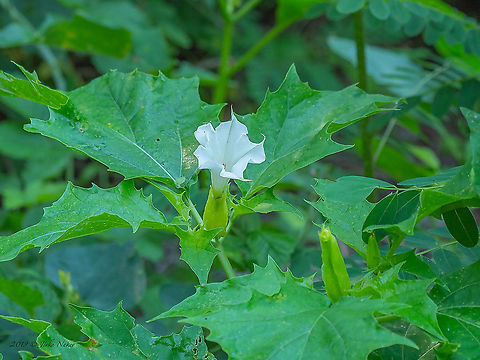
Naming
The genus name is derived from the plant's Hindi name, "dhatūra", ultimately from Sanskrit "...snipped..." 'white thorn-apple'. The origin of Neo-Latin "stramonium" is unknown; the name "Stramonia" was used in the 17th century for various "Datura" species.In the United States, the plant is called "jimsonweed", or more rarely "Jamestown weed" deriving from the town of Jamestown, Virginia, where English soldiers consumed it while attempting to suppress Bacon's Rebellion. They spent 11 days in altered mental states:
The James-Town Weed is supposed to be one of the greatest coolers in the world. This being an early plant, was gather'd very young for a boil'd salad, by some of the soldiers sent thither to quell the rebellion of Bacon; and some of them ate plentifully of it, the effect of which was a very pleasant comedy, for they turned natural fools upon it for several days: one would blow up a feather in the air; another would dart straws at it with much fury; and another, stark naked, was sitting up in a corner like a monkey, grinning and making mows [grimaces] at them; a fourth would fondly kiss and paw his companions, and sneer in their faces with a countenance more antic than any in a Dutch droll.In this frantic condition they were confined, lest they should, in their folly, destroy themselves—though it was observed that all their actions were full of innocence and good nature. Indeed, they were not very cleanly; for they would have wallowed in their own excrements if they had not been prevented. A thousand such simple tricks they played, and after eleven days returned themselves again, not remembering anything that had passed.
— Robert Beverley, Jr., "The History and Present State of Virginia, Book II: Of the Natural Product and Conveniencies in Its Unimprov'd State, Before the English Went Thither", 1705
Common names for "D. stramonium" vary by region and include thornapple and moon flower, and it has the Spanish name "toloache". Other names for the plant include hell's bells, devil's trumpet, devil's weed, "tolguacha", Jamestown weed, stinkweed, locoweed, pricklyburr, false castor oil plant, devil's cucumber, and thornapple.
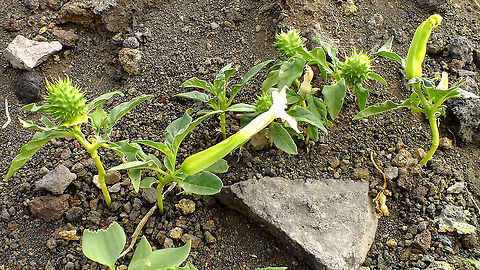
Habitat
"D. stramonium" is native to North America, but was spread widely to the Old World early. It was scientifically described and named by Swedish botanist Carl Linnaeus in 1753, although it had been described a century earlier by botanists such as Nicholas Culpeper. Today, it grows wild in all the world's warm and moderate regions, where it is found along roadsides and at dung-rich livestock enclosures. In Europe, it is found as a weed in garbage dumps and wastelands, and is toxic to animals consuming it.Through observation, the seed is thought to be carried by birds and spread in their droppings. Its seeds can lie dormant underground for years and germinate when the soil is disturbed. The Royal Horticultural Society has advised worried gardeners to dig it up or have it otherwise removed, while wearing gloves to handle it.
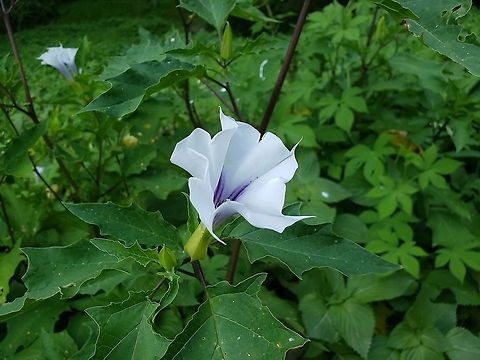
Defense
All parts of "Datura" plants contain dangerous levels of the tropane alkaloids atropine, hyoscyamine, and scopolamine, which are classified as deliriants, or anticholinergics. The risk of fatal overdose is high among uninformed users, and many hospitalizations occur among recreational users who ingest the plant for its psychoactive effects.The amount of toxins varies widely from plant to plant. As much as a 5:1 variation can be found between plants, and a given plant's toxicity depends on its age, where it is growing, and the local weather conditions. Additionally, within a given plant, toxin concentration varies by part and even from leaf to leaf. When the plant is younger, the ratio of scopolamine to atropine is about 3:1; after flowering, this ratio is reversed, with the amount of scopolamine continuing to decrease as the plant gets older. In traditional cultures, a great deal of experience with and detailed knowledge of "Datura" was critical to minimize harm. An individual seed contains about 0.1 mg of atropine, and the approximate fatal dose for adult humans is >10 mg atropine or >2–4 mg scopolamine.
"Datura" intoxication typically produces delirium, hallucination, hyperthermia, tachycardia, bizarre behavior, urinary retention, and severe mydriasis with resultant painful photophobia that can last several days. Pronounced amnesia is another commonly reported effect. The onset of symptoms generally occurs around 30 to 60 minutes after ingesting the herb. These symptoms generally last from 24 to 48 hours, but have been reported in some cases to last as long as 2 weeks.
As with other cases of anticholinergic poisoning, intravenous physostigmine can be administered in severe cases as an antidote.
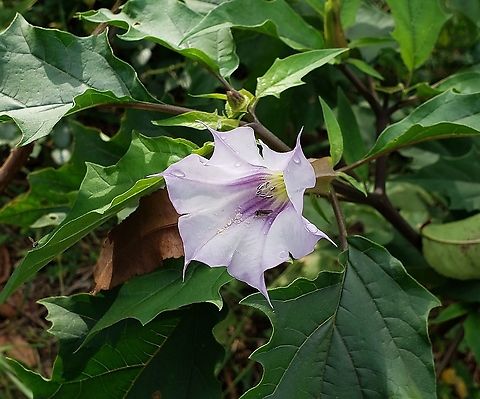
Uses
"D. stramonium" has been used in various treatments of traditional medicine or drug abuse as well as a hallucinogen and deliriant that is taken entheogenically for intense visions. It contains tropane alkaloids which produce the hallucinogenic properties, and may be severely toxic.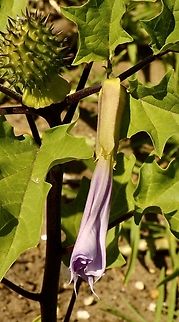
Cultural
The American artist Georgia O’Keeffe painted jimson weed several times. She was fond of the flowers, which grew wild around her New Mexico house. These paintings of the exotic white pinwheel blooms, hugely magnified, are among her most familiar works. In 2014 one such painting sold for $44 million, a record price for a female artist's work.It was also used as the basis of the drug known as Bliss in the video game "Far Cry 5".
References:
Some text fragments are auto parsed from Wikipedia.